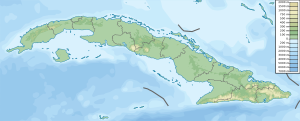Mogotes de Jumagua facts for kids
The Mogotes de Jumagua are a group of eight tall, rocky hills made of limestone in the Villa Clara Province of Cuba. These special hills are called mogotes in Spanish. They are part of the Heights of the Northwest mountain range in central Cuba. You can find them about two kilometers southwest of the city of Sagua la Grande.
These rocky peaks formed a very long time ago, during the Upper Cretaceous period. They are connected to each other and have huge caves inside. Scientists are very interested in the Mogotes de Jumagua because many different plants and animals live there in a small area. It's like a tiny island of nature. Some of the plants and animals found here are leftovers from Cuba's ancient forests. The Cuban government has made this area a nature reserve, protecting about 4.79 square kilometers (1.85 sq mi) of land.
Contents
History of Jumagua's Mogotes
Before 1970, no one had really studied the Mogotes de Jumagua scientifically. People didn't think they were very important. In fact, some even thought about digging up the limestone for building materials. Only a few students or curious travelers visited the hills. Some people even looked for gold, because a local story said a pirate hid treasure there. Because of this, no one knew how important the area was for wildlife, history, or caves.
In the 1970s, everything changed. A group called the Sabaneque Speleological Group from Sagua la Grande started exploring. They began making maps of the region and listing all the plants and animals in the caves. They found that the small caves were actually a huge system of underground caverns with lakes and rivers!
Amazing Discoveries in the Caves
The Sabaneque Group found many rare animals that live only in these caves. One amazing discovery was a unique type of scorpion. Local farmers had always talked about a special scorpion that lived only in the Mogotes, and the scientists proved their stories were true.
They also found colonies of giant fisher bats, cave tortoises, blind fish, and crabs. Another cool discovery was the American eel, Anguilla rostrata. These eels usually live in the ocean, but they come into rivers and lakes to have their babies. Finding them here shows how well they can adapt to different places.
Scientists also found old fossils. They discovered the fossil of a snail called Pseudomiltha sp. which is now extinct. They also found bones of a giant rodent called Megalocnus rodens. This rodent was so big that scientists sometimes call it the "Cuban bear." Even more exciting, they found bones and other signs that indigenous people lived in the area long before the Spanish arrived.
The Little Palms of Jumagua
One of the most important discoveries was a plant: the forgotten Palmitas de Jumagua (which means "Jumagua's little palms"). This palm, called Hemithrinax ekmaniana, grows only in these hills and nowhere else in the world!
Because of all these amazing discoveries, the Sabaneque Speleological Group created the first maps of the caves and the first list of all the plants and animals in the Mogotes forest. They also showed that the area was an important historical site for Cuba's native people. Thanks to their work, these small mountains became a Natural Park. This helped save them for future generations to enjoy and study.
Local Legends of Jumagua
Like many wild places in Cuba, the Mogotes de Jumagua have many interesting local stories and legends.
The Mother of Waters
In Afro-Cuban stories, there's a creature called the "Mother of Waters." She is half-serpent and half-woman. She is said to live in rivers and ponds and sometimes pulls people or animals into her deep home. Her children, called "Guijes," are small black children who also live in jungle ponds and play tricks on travelers. People in the 19th and early 20th centuries claimed to have seen the Mother of Waters or her tracks near Jumagua's Mogotes. Since the story about the special scorpion turned out to be true, the Sabaneque Group even looked for a very large snake in the caves. While Cuba has a few large snakes, the group thought maybe a visitor from another country brought a baby anaconda (or similar snake) that grew up in the caves. But so far, they haven't found any proof, like bones or skin, that a giant snake ever lived there.
The Pirate's Hidden Treasure
Another colorful story is about pirates. The legend says that one day, a pirate captain and some of his crew landed on the coast nearby. They hid a treasure in the Mogotes. When they went back to the coast, the captain realized his second-in-command was missing. The smart captain figured out that the officer had stayed behind to steal the treasure. A fight broke out between the pirates and the officer (who might have become a bandit). The pirates had to leave without their treasure. Whether this story is true or not, it has inspired many local people to search for the lost gold in the hills.
Historical Hiding Places
What we know for sure is that the caves in the Mogotes were used as hiding places. During the time of slavery, runaway slaves used them as camps. Later, during Cuba's fight for independence in 1895, the "Sagua Brigade" of Mambí warriors also used the caves as a safe haven.
See also
 In Spanish: Mogotes de Jumagua para niños
In Spanish: Mogotes de Jumagua para niños


